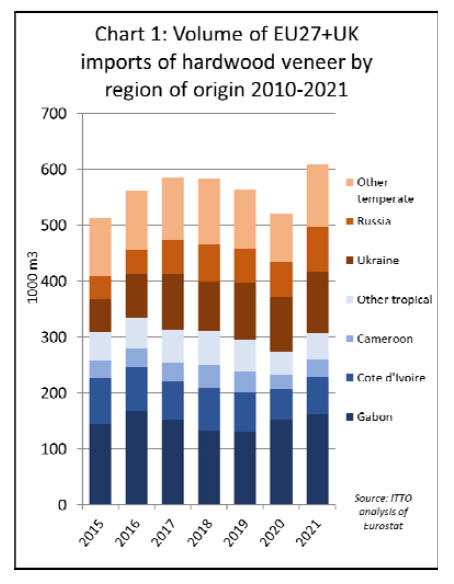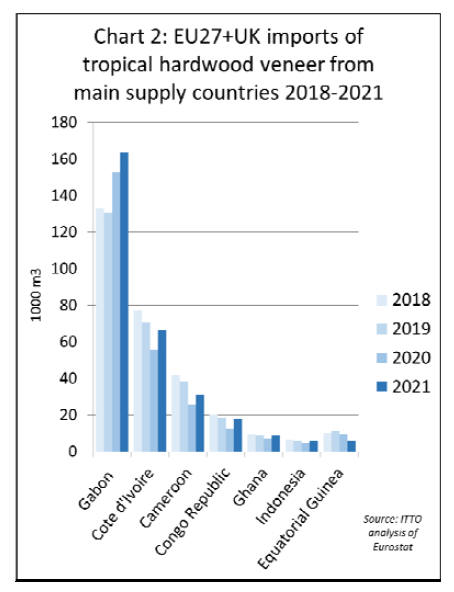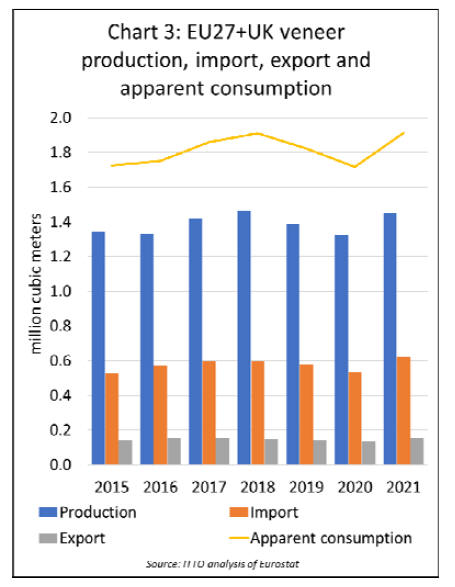|
Report from
Europe
European veneer consumption rebounded by 10% in
2021
In 2021, the 27 countries of the EU together with the UK
(UK27+UK) imported 609,000 cu.m of hardwood veneer
from outside the region, 17% more than in 2020.
EU27+UK imports from temperate countries increased
23% to 303,000 cu.m in 2021 while imports from the
tropics were up 11% to 307,000 cu.m (Chart 1).
In 2021, tropical hardwood accounted for just over 50% of
EU27+UK hardwood veneer imports, down from 53% in
2020 and continuing a long term decline from nearly 70%
a decade before. The tropical loss of import share in this
sector in recent years is primarily due to rising EU27+UK
imports of veneer from Ukraine and Russia as both
countries tightened log export controls and attracted new
investment in veneer production facilities.

EU27+UK imports of tropical rotary veneer have also
fallen as production of tropical hardwood plywood inside
Europe has been replaced by imports of finished plywood
products, and the tropical plywood sector as a whole has
faced mounting competition from Chinese and Russian
products.
Demand for tropical sliced veneer has been affected in the
long term by shifting fashions in the decorative hardwood
sector away from tropical wood towards temperate
species, particularly oak.
Gabon is now by far the largest tropical supplier of
hardwood veneer to the EU27+UK, volume rising 7% to
164,000 cu.m in 2021, following a 17% rise the previous
year (Chart 2).
Nearly two thirds (65%) of EU imports of veneer from
Gabon are destined for France, with the remainder going
to Greece (15%), Italy (10%) and Spain (5%).
Apart from Gabon, the other large tropical veneer
suppliers to the EU27+UK are Cote d'Ivoire (+21% to
66,000 cu.m in 2021, mainly to Italy, Spain and Romania),
Cameroon (+23% to 31,000 cu.m in 2021 mainly to Italy
and Spain), and the Republic of Congo (+41% to 18,000
cu.m in 2021, mainly to Greece and France).

Consumption of hardwood veneers in the EU27+UK was
already falling in 2019 before the onset of the pandemic
driven by declining confidence in the European wood
products manufacturing sector as the European and global
economy showed signs of stagnation.
A 5% fall in consumption in 2019 was followed by a 6%
decline in the first year of the pandemic in 2020.
However, consumption rebounded strongly, by around
11% to reach 1.9m cu.m in 2021, recovering the ground
lost in the previous two years (Chart 3).

The same factors that drove a sharp rise in EU27+UK
sawn hardwood consumption in 2021 were evident in the
veneer sector. This included the boom in private sector
demand as homeowners invested in DIY, renovation and
new furniture as spending declined on restaurants,
vacations, and other leisure activities.
While this source of demand was abating in the second
half of 2021, it was offset by rising activity in the
commercial sector as large government stimulus measures
began to kick in. In 2020 and 2021, these measures largely
consisted of fiscal initiatives by national governments,
such as VAT cuts, tax deferrals and loan guarantees for
firms.
From 2022, money from the EU-wide €750 billion
Recovery and Resilience facility is being disbursed with a
focus on green investments, such as energy-efficient
construction and building renovation. These funds are
targeted towards highly indebted countries in Eastern and
Southern Europe, notably Spain and Italy which are also
large consumers of veneers.
Another factor driving rising demand for veneer in some
parts of Europe is a partial switch away from solid lumber
in favour of veneered panels. This shift was happening
well before recent events, but there are reports from Spain,
for example, that it has accelerated again following sharp
rises in lumber prices since mid-2020. Continuing concern
that the Spanish economy is recovering only slowly from
the impacts of the pandemic, combined with general
unwillingness of buyers in this country to pay higher
prices, has led to a search for cheaper alternatives to
hardwood lumber in the country.
The recovery in European furniture production during
2021, rising 8% during the year after a 7% decline in 2020
according to Eurostat data, was a major driver of rising
veneer consumption last year. Although the war in
Ukraine means the outlook for European growth in 2022 is
now uncertain, the 4.4% growth in European furniture
consumption forecast for this year issued by Italian
furniture research organisation CSIL in January is some
grounds for optimism that veneer demand will remain
strong in this sector.
The war in Ukraine has more immediate implications for
the European veneer sector. Veneer imports from Ukraine
and Russia, which are now by far the largest external
suppliers of temperate hardwood veneer into the
EU27+UK, are expected to stop this year.
Together these two countries accounted for 64% of all
temperate hardwood veneer imported into the EU27+UK
in 2021. Between 2013 and 2021, EU27+UK imports of
hardwood veneer from Russia and Ukraine increased by
210% and 177% respectively.
The ability of EU domestic production to take up the slack
is impaired by the wider effects of the war on wood supply
in the EU member states of Eastern Europe.
This region, which now accounts for around half of all EU
veneer production, was already struggling with log supply
shortages due to COVID and following the introduction of
a log export ban by Russia at the start of this year. Now
the situation is even more challenging as logs are no
longer available from Ukraine and Belarus.
The war is also creating logistical and other problems for
manufacturers across Eastern Europe, notably a shortage
of truck drivers, with many freight operators relying
heavily on Ukrainian nationals and sharply rising fuel and
energy costs.
Encouraging revival in Italian hardwood market
One of the more encouraging, not to say surprising,
hardwood market trends in 2021 was a strong revival in
demand in Italy, a country marked by an almost
continuous decline in consumption in the previous decade
and which suffered severely from the early effects of the
COVID pandemic in 2020.
Italy experienced a large increase in hardwood
consumption during 2021 as the construction and furniture
manufacturing sectors were both growing strongly during
the year. Prospects for continued consumption growth in
2022 also seem good, the main concerns now being on the
supply side.
Italy's growth has been particularly boosted by Next
Generation EU funding for post COVID-recovery, a large
share of which has been allocated to the country. In total,
EUR 224 billion of Next Generation EU funding has been
assigned to Italy in the 2021-2026 period, with about 50%
earmarked for construction.
There is significant emphasis on projects that help the EU
meet zero carbon goals in this funding package, including
works to improve and rehabilitate older buildings to
improve energy performance.
The IHS Markit Italy Construction PMI climbed to a new
series high of 68.5 in February 2022, the 13th straight
monthly expansion. The PMI for residential construction
has been increasing at a record rate in Italy. After a 6.6%
contraction in 2020, Italian construction output is
estimated to have increased by about 12% in 2021. Italy's
wood furniture sector is also now expanding rapidly.
According to figures drawn up by Centro Studi
FederlegnoArredo, production turnover in Italy's wood
furniture sector, including wood component
manufacturers, was €49 billion, 26% more than in 2020
and up 14% compared to the pre-covid level in 2019.
Italian wood furniture exports last year exceeded €18
billion, up 21% compared to 2020 and 7% more than in
2019.
Wood furniture consumption in Italy's domestic market
was up 29% compared to the previous year and 19% on
the pre-covid level in 2019.
According to FederlegnoArredo growth in Italy's domestic
market is due to the "effectiveness of tax breaks such as
the 'bonus mobili' and the rediscovered centrality of the
home in the lives of Italians".
Much of the new demand has come from the home
furnishings and garden furniture sectors while the contract
corporate and, particularly, the hospitality sectors have
remained weak. Italy's large tourist sector has been hit
heavily by the pandemic.
Istat data shows that in the first nine months of 2021 the
number of guests in Italian hotels dropped by 44.3% while
Assoaeroporti estimates that Italian air traffic in 2021 was
still 59% down on the pre-pandemic level in 2019. On the
strength of such evidence, FederlegnoArredo comment
that ˇ°the contract sector will have to wait until at least
2023, if not 2024, to return to pre-covid levels."
FederlegnoArredo also comment that, while the increase
in domestic sales and exports during 2021 is encouraging
and shows a return to pre-covid levels in Italy's wood
furniture supply chain, "the high cost of energy, shortage
of raw materials, and rising logistics costs risk reversing
the trend as early as the first months of 2022. And the war
in Ukraine, with all its consequences, is worsening a
situation that was already beginning to deteriorate".
While Italian wood supply is more diversified than many
other countries, FederlegnoArredo note that Russia and
Ukraine are critical suppliers of wood material to the
Italian and wider European wood manufacturing sector,
while Russia is also an important export market for highend
Italian furniture, accounting for around €430m each
year.
FederlegnoArredo point out that the inevitable wood
supply squeeze due to war in Ukraine comes on top of an
already critical supply situation. Depending on species,
wood prices in Italy increased by 130% to 280% between
autumn 2020 and August 2021 and only declined slowly
after that and for many products were still more than
double pre-covid levels when Russia invaded Ukraine in
February 2022.
The situation in Ukraine is creating particularly significant
problems in the in the supply of birch logs and associated
products, for which Russia is the world's largest producer.
Lack of birch supply not only impacts on furniture and
other wood manufacturing but has significant knock-on
effects throughout European industry since birch is widely
used for industrial packaging, trucking floors, floors and
structural beams.
The volumes involved are so large ¨C together Russia,
Belarus and Ukraine account for around 50% of all wood
tonnage imported into the EU - that they cannot be readily
replaced.
Commenting on the critical supply situation,
FederlegnoArredo President Claudio Feltrin notes that "it
is necessary and urgent to find alternative sources of
supply, such as poplar or beech, possibly of national
origin, accelerating the objectives and actions envisaged
by the National Forest Strategy".
However the ability to increase domestic log harvests in
Italy, as in many other parts of the EU, is constrained, at
least in the short to medium term, by high levels of
fragmentation in the forest sector. Although Italy is host to
over 11 million hectares of forest (38% of national land
area) and to a globally significant wood processing sector,
around 80% of wood material supply to this sector is
imported.
Efforts are being made to mobilise more wood from Italy's
domestic forests, for example a draft new Consolidated
Forestry Law was published in 2018, and now awaits a
series of implementing decrees, which aims to standardize
and simplify forestry regulations across the country. But
this can go only so far to improve wood supply in a
country in which two thirds of forests are in the hands of
tens of thousands of small forest owners, and which lacks
a primary wood processing industry.
According to Gian Paolo Potsios, managing partner for the
European branch of the US management company
Timberland Investment Resources, speaking to the Italian
business journal Economia, "Italy has one of the most
important forest assets in Europe, in terms of quality and
quantity. Unfortunately, with certain exceptions mostly in
Northern Italy, it is a neglected heritage, managed in a
confused way, with too many intermediaries, which
constrain the sector, making it difficult and unappealing to
exploit this resource."
FederlegnoArredo has various initiatives in place to
overcome these constraints. For example it is collaborating
with Chambers of Commerce and other institutions to
create an Italian wood exchange, a digital platform
designed to bring together buyers and sellers of Italian
wood. It is also working with universities and research
bodies to ensure that the most common species in Italy
(such as beech and chestnut) are certified as materials
suitable for use in construction.
But these projects will take time to significantly influence
the supply situation. In the short term FederlegnoArredo is
joining with other European wood manufacturing in
calling for regulations to prevent the export of logs from
the EU. Even this measure would only marginally improve
the supply situation.
FederlegnoArredo conclude their most recent market
analysis with the gloomy observation that "our companies
could find themselves managing a situation in which they
are unable to process orders due to the lack of raw
materials while they are oppressed by the high cost of
energy, which is already being reflected in the price lists
of finished productsˇ±.
|